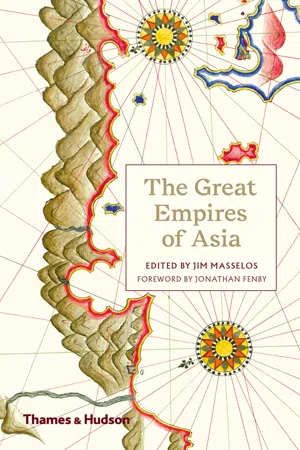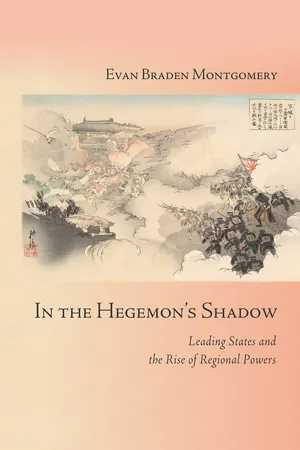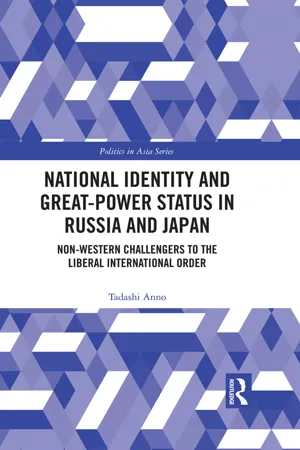History
Japanese Empire
The Japanese Empire refers to the historical period when Japan expanded its influence and control over various territories in Asia and the Pacific, particularly during the late 19th and early 20th centuries. This expansion was characterized by military conquest and colonization, and it had significant political, economic, and social implications for both Japan and the regions under its control.
Written by Perlego with AI-assistance
Related key terms
6 Key excerpts on "Japanese Empire"
- eBook - ePub
- Jim Masselos, Jonathan Fenby(Authors)
- 2018(Publication Date)
- Thames and Hudson Ltd(Publisher)
CHAPTER SEVEN
ELISE KURASHIGE TIPTONJapan: The Meiji Restoration 1868–1945T he Japanese Empire was short-lived, in comparison with the other Asian empires in this book. It lasted only fifty years, from its first territorial acquisitions in 1895 to its unconditional surrender in 1945. Nevertheless, at its height during the Second World War the empire spread across most of North-East and South-East Asia – occupying Korea, Taiwan, Micronesia, and the former British and Dutch colonies in South-East Asia and wielding de facto control over Manchuria, central and eastern China, and French Indochina. Most tellingly, the Japanese Empire was the only non-Western empire of modern times. This significance was not lost on contemporaries in the West or in other parts of Asia, and memories of the more brutal aspects of Japanese imperialism linger even into the 21st century.Before 1895, Westerners had seen Japan simply as the producer of beautiful, but strange and exotic, arts and crafts, which were displayed at world’s fairs and expositions such as the 1876 Philadelphia Centennial Exposition. However, Japan’s military defeat of China in 1895, and the consequent expansion of its influence over Korea, focused Western attention. The victory over China demonstrated that Japan had come a long way since the early 1860s. Now Western governments and commentators praised Japan’s military accomplishments, representing Japan as civilized and progressive. American foreign service official Harold Martin’s assessment of the war between China and Japan was typical:…the success of Japan in Korea means reform and progress – government, social and commercial – in that unhappy country.…The success of the Chinese means the forcing back of the Koreans to Oriental sluggishness, superstition, ignorance, and anti-foreign sentiment. It is a conflict between modern civilization, as represented by Japan, and barbarism, or a hopelessly antiquated civilization, by China.1 - eBook - ePub
Japan 1868-1945
From Isolation to Occupation
- Takao Matsumura, John Benson(Authors)
- 2014(Publication Date)
- Routledge(Publisher)
The war, we can now see, marked both an end and a beginning. Japan took advantage of the hostilities to declare war on Germany according to the terms of the 1902 Anglo-Japanese Alliance (by which, it will be recalled, Japan and Britain had agreed to assist the other if they found themselves at war with two or more adversaries). As the second Ôkurma cabinet declared, ‘Japan must take the chance of a millennium’ to ‘establish its rights and interests in Asia’. She sent military expeditions to German islands in the north Pacific and to German-leased territory in eastern China, which was still in turmoil following the overthrow of the Qing dynasty in 1911. Military gains were supported by diplomatic efforts, the Japanese delegation to the Paris Peace Conference which brought the war to a close retaining the territory which had been won by armed force. By the beginning of the 1920s, the first phase of Japan’s formal expansion was substantially complete. 37 The establishment of Japan’s formal empire was accompanied by a growing emphasis upon informal methods of control. It has been suggested already that this distinction between formal and informal methods of control (and thus between formal and informal imperialism) is fundamental to the understanding of modern imperial development. For example, British policy, Robinson and Gallagher believed, ‘followed the principle of extending control informally if possible and formally if necessary’. 38 Japanese policy was somewhat different. It followed the principle, some argue, of extending informal control as the preparation for, and precursor of, formal control. Of course, Japan had long used such devices of informal control as protectorates, spheres of influence and favourable treaty provisions in order to further her foreign policy aspirations - eBook - ePub
Modern East Asia: An Introductory History
An Introductory History
- David Y Miller(Author)
- 2014(Publication Date)
- Routledge(Publisher)
5The Rise of Imperial Japan
The most important geopolitical event in East Asia at the end of the nineteenth century and beginning of the twentieth was Japan’s replacement of the collapsing Chinese Empire as the region’s leading Asian power. Japan’s rise was the result of the success of Meiji leaders in remaking their country on the model of the West. In the pursuit of this goal, they created virtually from scratch an industrial economy unparalleled elsewhere in East Asia and, indeed, the non-Western world. At the same time, they turned the improvised imperial government of the 1870s into a Western-style constitutional monarchy and nascent parliamentary democracy. In addition, they developed a powerful army and navy, which they employed to build a colonial empire in Northeast Asia through victorious wars against China in 1894–95 and Russia in 1904–5. Supported by most Japanese, the Meiji leadership gained admission to the Western imperialist club and “quit Asia” culturally and psychologically. By the end of the Meiji era in 1912, however, some Japanese were beginning to have misgivings about their identification with the West and the costs of Japan’s headlong rush to modernity.Meiji Modernization
Why did the Japanese, alone among East Asians, succeed in transforming themselves into a modern industrial and military power in the late 1800s? Some explanations favor cultural factors, such as their tradition of borrowing from more advanced countries, specifically China. However, this tradition does not differentiate them from the Koreans and Vietnamese, who also borrowed from China but were just as reluctant as the Chinese to emulate the Western model. Other interpretations emphasize contingencies such as Japan’s good fortune in escaping colonization by the Western imperialists, and having unusually able and farsighted leadership at a critical juncture in its history. These contingencies are no doubt important, but they leave unanswered the larger question of why the Japanese as a people embraced Westernization. As suggested in previous chapters, the late-Tokugawa setting offers some clues. It is surely important, for example, that the samurai were predisposed to accept nationalism and jettison feudalism. Likewise, Meiji industrialization has its roots in the responsiveness of the late-Tokugawa economy to market incentives and the widespread diffusion of an “achievement ethic.” - eBook - ePub
War, Peace and International Relations
An introduction to strategic history
- Colin S. Gray(Author)
- 2013(Publication Date)
- Routledge(Publisher)
12 World War II in Asia–Pacific, I
Japan and the politics of empireReader's guide: The connections between the two wars. The growth of the Japanese Empire. US–Japanese relations and the approach to war.Introduction: global war
In its origins, stakes and purposes, the war in Asia–Pacific was all but entirely unrelated to the war in Europe. Nevertheless, it is still accurate, if strangely so, to regard the war against Japan as an integral part of World War II. The principal connection between the two wars, half a world apart, was that it was only the ongoing war in Europe that emboldened Japan to seek a grand military solution to its strategic problems. Had there been no active conflict in Europe, Japanese prospects for success would have been so poor that war against the European colonial powers and the United States almost certainly would have been rejected as the policy choice. Even as it was, in 1941 Japanese leaders were far from united in a determination to fight. Context is vital. In 1940–1, as Japan's material strategic condition worsened because of American-led economic sanctions, so the radical changes in the global strategic context effected by Germany's victories appeared to offer a unique opportunity for Japan to exploit.It is useful to draw attention to an obvious political difference between the war in Europe and that in Asia–Pacific. Certainly by 1939, probably after 1936, or even as early as 1933, with hindsight it is plausible to argue that war in Europe was unavoidable. Germany, which is to say Adolf Hitler, wanted war. He might briefly be deterred tactically, but not strategically or politically. By contrast, Japan did not want war with the United States, though war with the British and the Dutch was unavoidable, given Tokyo's need for reliable access to the raw material resources (especially oil and rubber) of South East Asia. It should have been possible to coerce by menaces, perhaps even to persuade Japan not to embark on the inherently extremely hazardous course of war. But for a potential combatant to agree to be deterred when the stakes are perceived to be of the highest order, it must be deprived of any hope of military success. Also, it should be offered a politically tolerable alternative to war. In 1941, alas, those crucial conditions did not apply, as the world learned on 7 December, when the Imperial Japanese Navy attacked Pearl Harbor. - eBook - ePub
In the Hegemon's Shadow
Leading States and the Rise of Regional Powers
- Evan Braden Montgomery(Author)
- 2016(Publication Date)
- Cornell University Press(Publisher)
CHAPTER 4 Japan and the Creation of a New Order in East Asia, 1894–1902 From the end of the nineteenth century until the early twentieth century, the British government confronted a geopolitical environment in East Asia that was complex, dynamic, and very similar to the one that it faced in the Middle East many decades earlier. In both cases, policymakers were extremely concerned about Russian expansion into areas where Great Britain had considerable economic and strategic interests. Due to a combination of global commitments, resource limitations, and logistical constraints, officials also relied on preponderant powers in these peripheral regions to help mitigate the risk of containment failure. Finally, London’s informal alliances with local hegemons had to be reevaluated once rising powers attempted to alter the status quo. Just like the Ottoman Empire, the Chinese Empire was “the traditional supreme power” in its neighborhood. 1 These once great powers shared a number of more notorious characteristics as well. Both had extremely weak central governments that struggled to control their extensive territories; they suffered from institutional decay and domestic unrest that sapped their strength; and they became inviting targets for stronger actors that sought territorial concessions, exclusive economic spheres of interest, or both. In fact, by the end of the century, “China had taken the place of Turkey as the pre-eminent Sick Man.” 2 Meanwhile, Japan was in the midst of sweeping political, economic, and military reforms, not unlike Egypt under Mehmet Ali. The need to fend off encroaching outside powers triggered a process of defensive modernization and drove it to emulate many of the Western institutions and technologies that it had shunned during more than two centuries of self-imposed isolation - eBook - ePub
National Identity and Great-Power Status in Russia and Japan
Non-Western Challengers to the Liberal International Order
- Tadashi Anno(Author)
- 2018(Publication Date)
- Routledge(Publisher)
57 In 1933, the diplomatic commentator Saegusa Shigetomo made this point, arguing that Japan should stand by the interest of “international imperialism”: “it is extremely inconsiderate of some people in our country to cry, ‘Down with Britain,’ or ‘Emancipate 300 million Indians’… Greater Asianism is a principle which eventually leads to Japan’s withdrawal from Manchuria, and to the recognition of the independence of Korea and Taiwan… Indeed, in Jinan, Manchuria, and in Shanghai, Japan has fought for international imperialism, and against anti-imperialist forces.” His proposal was to improve the relations among the three great naval powers (Britain, the United States, and Japan) by “demonstrating how the great powers have common interests” in imperialism (Saegusa 1933, 73–79). More fatefully, during the critical US-Japanese negotiations in the months leading up to Pearl Harbor, the Japanese delegation suggested that the United States had no good reason to single out Japan for criticism, for Japan was essentially following the example of what other great powers had done in the previous century. To this, President Roosevelt responded that, while territorial expansion may have been accepted in the nineteenth century, world public opinion in the twentieth century does not permit such actions (Hosoya et al. 1984, 178).58 As Shiratori Toshio, the most vocal proponent of Japanism within the Foreign Ministry, noted: “if Japan’s continental policy is legitimized only by material needs, we cannot refute the charge that Japanese actions amount to invasion and imperialism… We must recognize the spiritual foundations of Japan’s continental policy, that is, the mission of the Japanese race, and the ideals on which Japan was built. Our advance into the continent must be for carrying out this great mission” (Shiratori 1938, 23).59 As Peter Duus pointed out (1996, xxiii), Japanese politicians and intellectuals frequently referred to the “world-historical significance” of the Greater East Asian Co-Prosperity Sphere, and associated it with a new phase of world history. “The persistent emphasis on the ‘new’ – a ‘new conception’ of peace in Asia, a ‘new epoch in the annals of mankind,’ a ‘new world order’ – signaled a compelling and deeply felt urge to break free from followership.”60 The “Principles of Internal Guidance of the Future Chinese Government
Learn about this page
Index pages curate the most relevant extracts from our library of academic textbooks. They’ve been created using an in-house natural language model (NLM), each adding context and meaning to key research topics.





